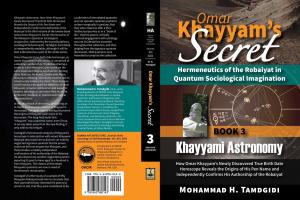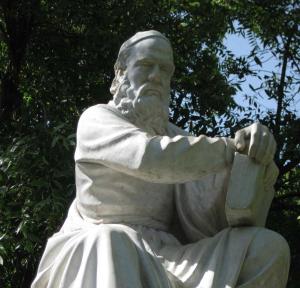Omar Khayyam’s Pen Name Roots Found, Authorship of 1000-Robaiyat Divan Confirmed
Omar Khayyam's 'tent-maker' pen name originated in his true horoscope. A signature quatrain offering a correct Gemini address points to a 1000-Robaiyat divan.
In the third book of the series, reviewing the findings of its preceding two books, Tamdgidi notes how the discovery of Omar Khayyam’s true date of birth (AD 1021) and the reconfirmation of his true date of passing (AD 1123) in this series so far were made possible by deciphering the clues given in Khayyam’s birth horoscope. Omar Khayyam’s true birth date horoscope, as newly discovered in this series, is comprised of a dazzling number of Air Triplicities sharing a vertex on a Sun-Mercury Cazimi point on the same Ascendant degree 18 of Gemini. Among other features, his Venus, Sextile with Moon, also plays a lifelong, secretively creative role to intentionally balance his chart. These features would not have escaped the attention of Omar Khayyam, a master astronomer and expert in matters astrological, no matter how much he embraced, doubted, or rejected astrological interpretations.
In this third book of the series, conducting an in-depth hermeneutic analysis of Khayyam’s horoscope, Tamdgidi reports having discovered the origins of Khayyam’s pen name in his horoscope. The long-held myth that “Khayyam” was a parental name, even if true, in no way takes away from the new finding; it only adds to its intrigue.
Tamdgidi’s hermeneutic analysis of Khayyam’s horoscope in intersection with extant Khayyami Robaiyat also leads him to discover an entirely neglected signature quatrain that he proves could not be from anyone but Khayyam, one that provides a reliably independent confirmation of his authorship of the Robaiyat. He also shows how another neglected quatrain reporting its poet to have aged to a hundred is from Khayyam. This means all the extant Khayyami quatrains are now in need of hermeneutic reevaluation.
Tamdgidi observes, "it was thanks to the horoscope that we discovered a textually reliable explanation for his pen name, 'Khayyam,' and, … were able to discover for the first time a hitherto neglected and non-“wandering” Khayyami quatrain that has Khayyam’s astrological signature imprinted directly in its lines and can therefore be regarded as a long-sought after, self-authenticating, signature robai composed by our historical Omar Khayyam." “And, finally," he notes, "it was as a result of all the above that we were able to consider it possible that a second quatrain reporting its composer’s having reached the age of one hundred could be regarded as a robai authentically traceable to the historical Omar Khayyam."
Tamdgidi’s further study of a sample of fifty Khayyami Robaiyat leads him to conclude that their poet definitively intended the poems to remain in veil, that they were considered to be a collection of interrelated quatrains and not sporadic separate quatrains written marginally in pastime, that they were meant to offer a life’s intellectual journey as in a “book of life,” that the poems’ critically nuanced engagement with astrology was not incidental but essential throughout the collection, and that, judging from the signature quatrain discovered, 1000 quatrains were intended to comprise the collection.
According to Tamdgidi, "such a collection of Robaiyat, as a lifetime’s project, would then be not just a pastime preoccupation, but central to the life of a Khayyam seeking to know and see God’s Love as the meaning of existence. It also served as a way of balancing and integrating the knowing and feeling and sensing aspects of the knowledge needed in search of God’s truth and meaning of existence. To find a way to not just know but also see, would challenge merely intellectual knowledge that is amply supplied in a native’s Sun-Mercury Cazimi-stitched array of Air Triplicities. The collection would be the work of Khayyam’s Venus, in Sextile aspectation with the Moon, to pursue the hidden work on himself needed as arising from the geometry of his natal chart.”
——————————————————————
On that day when they fastened this blue dome above,
Then fastened this dot to mid-Gemini thereof,
Like a candle’s flame burning for eternity
They fastened me with a thousand threads to Thy Love.
— Omar Khayyam (Tamdgidi translation)
——————————————————————
About the Author:
Mohammad H. (Behrooz) Tamdgidi, Ph.D., is the founding director and editor of OKCIR: Omar Khayyam Center for Integrative Research in Utopia, Mysticism, and Science (Utopystics) and its journal, "Human Architecture: Journal of the Sociology of Self-Knowledge" (ISSN: 1540-5699), which have served since 2002 to frame his independent research, pedagogical, and publishing initiatives. Tamdgidi holds a Ph.D. and M.A. in sociology in conjunction with a graduate certificate in Middle Eastern studies from Binghamton University (SUNY). He received his B.A. in architecture from U.C. Berkeley. He has previously also authored "Advancing Utopistics: The Three Component Parts and Errors of Marxism" (Routledge/Paradigm) and "Gurdjieff and Hypnosis: A Hermeneutic Study" (Palgrave Macmillan). He is a former associate professor of sociology specializing in social theory at UMass Boston and has taught sociology at SUNY-Binghamton and SUNY-Oneonta. Due to research commitments facing urgent deadlines, and preferences for written communication and privacy, the author can be reached only by email. All he wishes to share are done through his publications.
Mohammad H. Tamdgidi
OKCIR: Omar Khayyam Center for Integrative Research
pressrelease@okcir.com
Legal Disclaimer:
EIN Presswire provides this news content "as is" without warranty of any kind. We do not accept any responsibility or liability for the accuracy, content, images, videos, licenses, completeness, legality, or reliability of the information contained in this article. If you have any complaints or copyright issues related to this article, kindly contact the author above.



